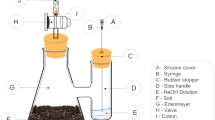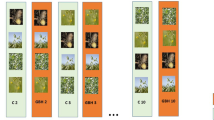Abstract
Absorption of14C-labeled herbicides from nutrient culture solution through the roots of sugarcane plants (Saccharum spp. hybrids) resulted in three major types of distribution. Labeled residues from atrazine, ametryne, and metribuzin moved easily through the xylem to the green leaves and were deposited mainly at the leaf margins and tip. Senescence and leaf abscission removed most of the deposit from the plant. Picloram translocated rapidly into the leaves, but appeared to recycle from older to younger leaves with only small portions remaining in the senescent leaves. Asulam and pentachlorophenol (PCP) were absorbed by the roots; residues did not pass into the xylem and remained fixed in the roots.
Foliar additions of labeled herbicides and growth regulators generally showed only minor absorption and translocation within the leaf. Weathering processes and volatility during a 6- to 12-week period left variable amounts of residue, characteristic of individual compounds, adsorbed at the treated sites.
Similar content being viewed by others
References
Ashton, F. M.: Absorption and translocation of radioactive 2,4-D in sugarcane and bean plants. Weeds6, 257 (1958).
Burr, G. O.: Radioactive 2,4-D traced in plants. Ann. Rept. Exp. Sta. Hawaiian Sugar Planters' Assoc. (Honolulu). 49 (1950).
Hilton, H. W.: Pesticides and food additives in sugarcane and sugar products. Residue Reviews15, 1 (1966).
Hilton, H. W., Q. H. Yuen, B. V. Tucker, D. E. Pack, and J. N. Ospenson: Residues following treatment of sugarcane with radioactive diquat to control flowering. J. Agr. Food Chem.16, 906 (1968).
Hilton, H. W., Q. H. Yuen, and N. S. Nomura: Absorption of monofluoroacetate-2-14C ion and its translocation in sugarcane. J. Agr. Food Chem.17, 131 (1969).
Hilton, H. W., Q. H. Yuen, and N. S. Nomura: Distribution of residues from atrazine, ametryne, and pentachlorophenol in sugarcane. J. Agr. Food Chem.18, 217 (1970).
Hilton, H. W., N. S. Nomura, and S. S. Kameda: A simplified oxygen bomb combustion procedure for carbon-14 in agriculture materials and soils. Anal. Biochem.49, 285 (1972).
Hilton, H. W., S. S. Kameda, and N. S. Normura: Distribution of picloram residues in sugarcane. J. Agr. Food Chem.21, 124 (1973).
Hilton, H. W., N. S. Nomura, W. L. Yauger, and S. S. Kameda: Absorption, translocation, and metabolism of metribuzin (BAY-94337) in sugarcane. J. Agr. Food Chem.22, 578 (1974).
Nickell, L. G., and D. T. Takahashi: A review of chemical ripening studies with sugarcane in Hawaii. Repts. Hawaiian Sugar Technologists31, 47 (1972).
Tanimoto, T., and L. G. Nickell: Field control of sugarcane flowering in Hawaii with diquat. Proc. International Soc. Sugarcane Technologists12, 113 (1965).
Author information
Authors and Affiliations
Additional information
Published with the approval of the Director as Paper No. 355 in the Journal Series of the Experiment Station, Hawaiian Sugar Planters' Association.
Rights and permissions
About this article
Cite this article
Hilton, H.W., Nomura, N.S., Kameda, S.S. et al. Some patterns of herbicide and growth regulator intake, persistence, and distribution in sugarcane. Arch. Environ. Contam. Toxicol. 4, 385–394 (1976). https://doi.org/10.1007/BF02221036
Received:
Accepted:
Issue Date:
DOI: https://doi.org/10.1007/BF02221036




